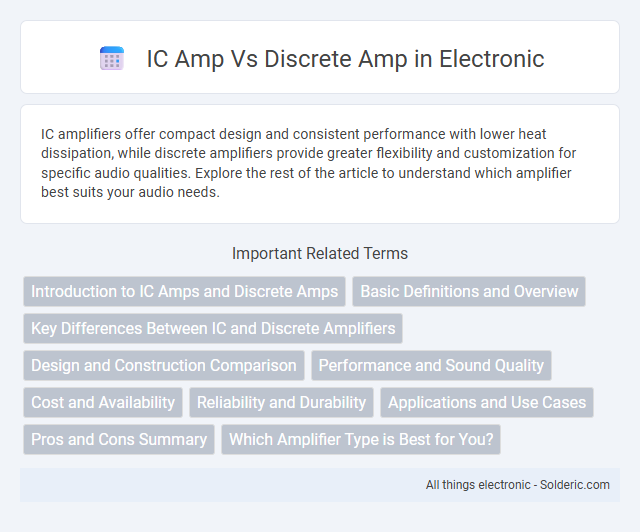IC amplifiers offer compact design and consistent performance with lower heat dissipation, while discrete amplifiers provide greater flexibility and customization for specific audio qualities. Explore the rest of the article to understand which amplifier best suits your audio needs.
Comparison Table
| Feature | IC Amplifier | Discrete Amplifier |
|---|---|---|
| Component Type | Integrated Circuit (IC) | Individual Transistors and Components |
| Size | Compact, Small Footprint | Larger, Bulkier |
| Cost | Lower Cost, Mass-Produced | Higher Cost, Customizable |
| Power Handling | Limited Power Output | High Power Capability |
| Performance | Good for General Purpose | Superior Audio Quality and Customization |
| Heat Dissipation | Less Efficient, Requires Cooling | Better Thermal Management |
| Design Flexibility | Fixed Design | Highly Flexible and Tunable |
| Reliability | High Reliability, Integrated Protection | Depends on Component Quality |
| Application | Consumer Electronics, Small Devices | High-End Audio, Professional Equipment |
Introduction to IC Amps and Discrete Amps
IC amps integrate multiple amplifier components on a single semiconductor chip, offering compact size, reduced cost, and consistent performance, making them ideal for mass-produced electronic devices. Discrete amps use individual transistors and components soldered separately on a circuit board, allowing greater design flexibility, higher power handling, and tailored audio quality for audiophiles and professional audio applications. Both amplifier types serve distinct needs with IC amps excelling in integration and efficiency, while discrete amps provide superior customization and potentially higher fidelity.
Basic Definitions and Overview
An IC amp, or integrated circuit amplifier, consists of multiple transistors and components fabricated on a single semiconductor chip, offering compact size and uniform performance. A discrete amp uses individual electronic components like transistors, resistors, and capacitors mounted separately, allowing for greater customization and potentially higher audio fidelity. Your choice depends on factors like circuit complexity, space constraints, and desired sound quality.
Key Differences Between IC and Discrete Amplifiers
IC amplifiers integrate multiple transistor components on a single chip, offering compact size, low cost, and consistent performance ideal for mass-produced electronics. Discrete amplifiers use individual transistors and components wired separately, allowing greater customization, higher power handling, and improved thermal management for high-performance audio or industrial applications. The key differences lie in IC amps emphasizing integration and efficiency, while discrete amps prioritize flexibility and superior sound quality.
Design and Construction Comparison
Integrated circuit (IC) amplifiers offer a compact design with multiple components fabricated on a single silicon chip, resulting in consistent performance, reduced noise, and lower manufacturing costs. Discrete amplifiers feature individual components such as transistors, resistors, and capacitors assembled on a circuit board, allowing customization and easier repairs but requiring more space and complex assembly. The choice between IC and discrete amplifiers depends on the balance between size, cost efficiency, and flexibility in design.
Performance and Sound Quality
IC amplifiers offer consistent sound quality with reduced distortion due to integrated circuit design, ensuring reliable performance across a wide frequency range. Discrete amplifiers typically provide superior sound fidelity and dynamic range by utilizing individual components tailored for audio precision. Audiophiles often prefer discrete amps for their warmer, more natural sound, while IC amps are favored for their compact size and energy efficiency.
Cost and Availability
IC amplifiers offer significant cost advantages due to mass production and standardization, making them widely available and affordable for consumer electronics. Discrete amplifiers, built from individual components, tend to be more expensive because of higher labor and material costs, often limiting their availability to specialized markets. The readily accessible and budget-friendly nature of IC amplifiers contrasts with the niche, higher-priced market presence of discrete amplifier designs.
Reliability and Durability
IC amplifiers offer superior reliability due to their integrated design, minimizing component failures and ensuring consistent performance under various conditions. Discrete amplifiers, while customizable, often face greater risks of wear and failure because of multiple individual components and solder joints. Your choice depends on whether you prioritize long-term durability with minimal maintenance or prefer tailored performance at the potential cost of reduced reliability.
Applications and Use Cases
IC amps are ideal for compact consumer electronics and portable devices where space and power efficiency are crucial, such as smartphones and hearing aids. Discrete amps excel in high-fidelity audio equipment and professional sound systems, offering superior customization and performance for audiophiles and studio use. Your choice depends on whether you prioritize integration and miniaturization or ultimate sound quality and flexibility.
Pros and Cons Summary
Integrated circuit (IC) amps offer compact design, lower cost, and energy efficiency, making them ideal for space-constrained applications. Discrete amps provide superior sound quality, greater customization, and easier repairability, but they tend to be larger, more expensive, and consume more power. Your choice depends on whether you prioritize convenience and affordability or performance and flexibility.
Which Amplifier Type is Best for You?
Integrated circuit (IC) amplifiers offer compact design, consistent performance, and energy efficiency, making them ideal for portable devices and everyday audio applications. Discrete amplifiers provide greater customization, higher power handling, and superior sound quality, preferred by audiophiles and professionals requiring precise audio control. Your choice depends on whether you prioritize convenience and efficiency or ultimate sound performance and customization flexibility.
IC amp vs Discrete amp Infographic

 solderic.com
solderic.com